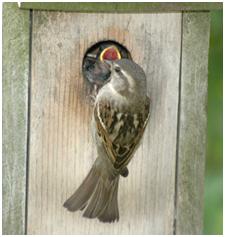Spring is a time when lots of people turn their attention to creating nest boxes for breeding birds. Many birds use next boxes – from wrens to owls – and as we lose nesting habitat, nest boxes create an opportunity that might otherwise be lost for some birds to find a safe place to raise their young. It’s fun to build your own nest box but often the plans available to work from don’t take into consideration the health and safety of the birds. I got a call this morning from an artist friend of mine who has decided to try her hand at making a bluebird house. I know that whatever she makes will be gorgeous and she is working from plans so that the birds have the right size cavity and ventilation. But nowhere on her plans does it give advice about paint or types of wood to use, and there are no tips on features that make life better for the birds inhabiting the box.
She initially called me to find out what kind of paint to use to attract bluebirds – were they sensitive to color? It’s a great question, and I don’t know the answer. While I am sure there are some birds which show color sensitivity one way or the other to nesting sites (Bowerbirds have a preference for different specifically colored objects in their bowers as an example), it gave me the chance to talk a little to her about using paint on the house. Birds are very sensitive to chemicals and since they weigh ounces or even grams, the introduction of any chemicals can be harmful to them if not fatal. I have been told that a good rule of thumb is not to paint the box at all. But that if you want to paint the outside of the birdhouse, use whatever paint you might use to paint a children’s toy – non-toxic is key here. Even though the interior may be unpainted, the chemicals can leach through or in the case of gases, just pass right through the wood into the nesting chamber.
I have also been told never to use preserved or pressure treated wood for bird houses (or much else, either) because it is preserved with arsenic (not in much use any longer) or copper, and this could prove fatal to the birds. Using pressure treated wood for any use should give us pause as the chemicals in the wood may leach into the environment, and both arsenic and copper can be harmful to aquatic as well as other creatures – humans included.
Another rule of thumb when building your birdhouse is not to provide perches at the entryway of the nest box as it gives predators a considerable advantage in gaining access to the hole and the babies inside. And you can help the fledglings gain access to the outside by roughening up the inside of the box so they can get a good foothold to climb out.
There are many resources on the internet with advice on building nest boxes, so if you are so inclined you can check around and find lots of info. This guide may be helpful in that it has features, dimensions and suggestions for things to think about when building and placing a nest box: http://extension.oregonstate.edu/catalog/pdf/ec/ec1556.pdf
 The nest boxes our family has built tend to be pretty basic but beloved by several types of birds as evidenced by this sparrow feeding her chick. This has been a very successful nest box for many years, although in all fairness, sparrows are not terribly difficult to please.I am looking forward to seeing what creative design my friend comes up with for her first bluebird box. After finding out that Bluebirds prefer to have a choice between several boxes before they settle on one, maybe she will build a few and set them all out for inspection. Bluebirds are picky, but they do like nest boxes. And, if you are lucky enough to build one that suits the peculiarities of a pair of bluebirds in your area, you can have a great view of these gorgeous birds raising their family.
The nest boxes our family has built tend to be pretty basic but beloved by several types of birds as evidenced by this sparrow feeding her chick. This has been a very successful nest box for many years, although in all fairness, sparrows are not terribly difficult to please.I am looking forward to seeing what creative design my friend comes up with for her first bluebird box. After finding out that Bluebirds prefer to have a choice between several boxes before they settle on one, maybe she will build a few and set them all out for inspection. Bluebirds are picky, but they do like nest boxes. And, if you are lucky enough to build one that suits the peculiarities of a pair of bluebirds in your area, you can have a great view of these gorgeous birds raising their family.